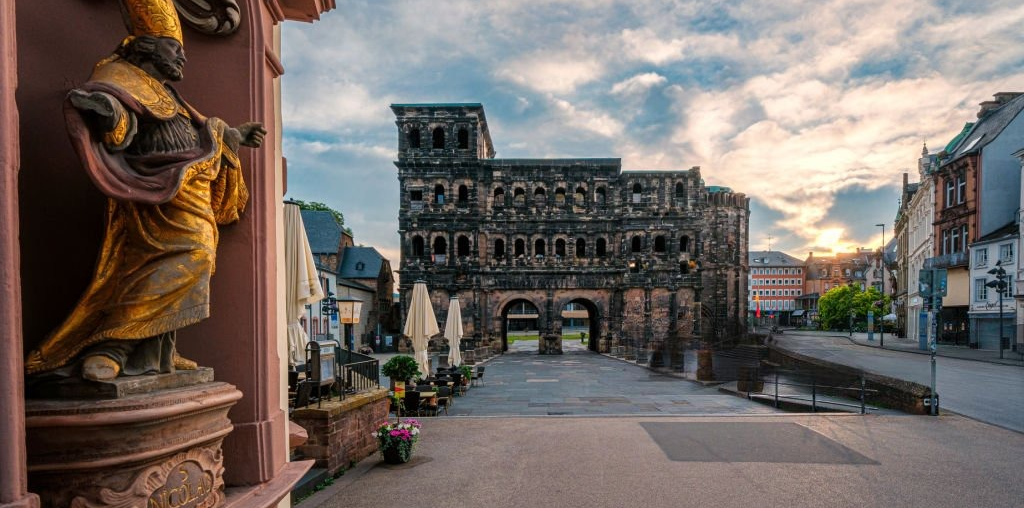Introduction
Porta Nigra, meaning “Black Gate,” is one of the most iconic and well-preserved Roman structures in Trier, Germany. Built around 170 AD, this massive city gate stands as a remarkable example of ancient Roman engineering. Constructed from enormous sandstone blocks without mortar, its longevity is a testament to the ingenuity of Roman craftsmanship. Today, it remains a UNESCO World Heritage site and a must-visit attraction for history lovers and travelers alike.
The Historical Significance of Porta Nigra
Trier, once known as Augusta Treverorum, was a vital city in the Roman Empire. Porta Nigra was part of the city’s fortifications, built to protect its residents from invasions. During the Middle Ages, the structure underwent a transformation when the Greek monk Simeon took residence within the gate. After his death, the site was converted into a church in his honor, a change that ultimately helped preserve the structure while many other Roman buildings in Trier were dismantled over time.
Architectural Excellence of Porta Nigra
Porta Nigra stands nearly 30 meters high and is constructed using massive sandstone blocks. The Romans, renowned for their engineering expertise, precisely cut and stacked these stones without mortar, relying on their weight and perfect alignment to hold the structure together. The gate features two imposing towers, arched passageways, and intricately designed openings, showcasing the advanced construction techniques of ancient Rome.
Recognition as a UNESCO World Heritage Site
In 1986, Porta Nigra was designated a UNESCO World Heritage site, recognizing its immense historical and architectural significance. Alongside other ancient Roman monuments in Trier, it remains a crucial link to the past, providing insights into Roman urban planning and military defenses. Every year, thousands of tourists visit Porta Nigra to marvel at its resilience and grandeur.
Visiting Porta Nigra: Essential Information
Location and Accessibility
Porta Nigra is centrally located in Trier, making it easily accessible by train, bus, or car. Luxembourg Airport, just an hour away, provides convenient international access for travelers.
Entry Fees and Opening Hours
- Opening Hours: Typically open daily from 10 AM to 6 PM (hours may vary seasonally)
- Entry Fee: Around €4 for adults and €2 for children (prices may change)
Visitors can explore the gate’s interiors, climb its towers for breathtaking city views, and join guided tours to gain deeper insights into its history.
Fascinating Facts About Porta Nigra
- It is the largest surviving Roman city gate north of the Alps.
- The structure was never fully completed, as evident in some unfinished sections.
- Its dark appearance results from centuries of exposure to the elements.
- Napoleon Bonaparte ordered the removal of medieval modifications in the 19th century to restore its original Roman design.
Frequently Asked Questions (FAQs)
1. Why is it called Porta Nigra?
The name “Porta Nigra” translates to “Black Gate” in Latin, referring to the darkened sandstone blocks caused by natural aging and environmental exposure.
2. Can visitors enter Porta Nigra?
Yes, visitors can explore its passageways, staircases, and towers, which offer spectacular views of Trier.
3. What makes Porta Nigra historically significant?
Its outstanding preservation, innovative Roman construction techniques, and role in the city’s defenses make it an invaluable historical landmark.
4. Was Porta Nigra part of a larger Roman fortification?
Yes, it served as one of the main entrances to Trier and was a key part of the city’s protective walls.
5. What other historical sites are near Porta Nigra?
Nearby attractions include Trier Cathedral, the Basilica of Constantine, and the Roman Amphitheater, all of which contribute to Trier’s rich cultural heritage.
Conclusion
Porta Nigra stands as a timeless symbol of Trier’s Roman heritage, captivating visitors with its historical significance and architectural brilliance. Whether you are a history enthusiast, an architecture lover, or a traveler exploring Germany’s past, this magnificent structure offers a unique glimpse into the grandeur of ancient Rome. A visit to Porta Nigra is not just a journey through history—it’s an experience of Roman ingenuity at its finest.




